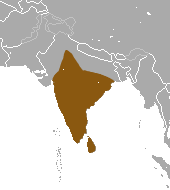The ruddy mongoose (Urva smithii) is a mongoose species native to hill forests in India and Sri Lanka.[1]
| Ruddy mongoose | |
|---|---|
 | |
| Scientific classification | |
| Domain: | Eukaryota |
| Kingdom: | Animalia |
| Phylum: | Chordata |
| Class: | Mammalia |
| Order: | Carnivora |
| Suborder: | Feliformia |
| Family: | Herpestidae |
| Genus: | Urva |
| Species: | U. smithii |
| Binomial name | |
| Urva smithii (Gray, 1837) | |
 | |
| Ruddy mongoose range | |
| Synonyms | |
|
Herpestes smithii | |
Description
The ruddy mongoose's fur is brownish and coarse, long in hindquarters, but short in other parts of the body. Its head to body length is 40–45 cm (16–18 in) with a 36 cm (14 in) long tail. Males are larger and heavier than females with a weight of 2.2 kg (4.9 lb); females weigh about 1.2 kg (2.6 lb). Tail constitute about 75–90 % of body length. It is distinguished by the Indian grey mongoose by its slightly larger size and jet black-tipped tail.[2]
Distribution and habitat


The ruddy mongoose is mainly a forest-living animal and prefers more secluded areas. It has also been recorded in secluded paddy fields and in comparatively open fields.[3]
Taxonomy
Herpestes smithii was the scientific name proposed by John Edward Gray in 1837 for a zoological specimen in the collection of the British Museum Natural History.[4] All Asian mongooses are now thought to belong in the genus Urva.[5]
Subspecies:[6]
- U. s. smithii
- U. s. thysanurus
- U. s. zeylanius
Ecology and Behavior
It usually carries its black tipped tail tip curved upward which is visible from a distance. Like other mongooses, it hunts by day and by night,[3] and feeds on birds, rat snakes, land monitors, rodents and snails. Generally a solitary animal, rarely can be seen in pairs during mating season. However, mother and pup family groups consisting about five animals have been observed.[2]
It is found in thick jungles, forest edges near paddy fields and tea estates. However, withdraw quickly in a crevice or underneath a rock shelf during human confrontation. When cornered, they fight fearlessly with loud and shrill cries.[2]
In culture
In Sri Lanka this animal is usually regarded as an unlikable animal and a pest. The golden palm civet (Paradoxurus zeylonensis), altogether a different species endemic to Sri Lanka, is also called hotambuwa due to similar appearance and coloration.
References
External links
Wikiwand in your browser!
Seamless Wikipedia browsing. On steroids.
Every time you click a link to Wikipedia, Wiktionary or Wikiquote in your browser's search results, it will show the modern Wikiwand interface.
Wikiwand extension is a five stars, simple, with minimum permission required to keep your browsing private, safe and transparent.

